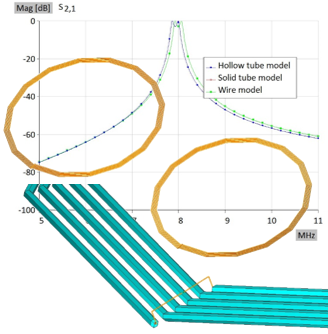Modeling Wires in Planar Spiral Coils
21-Sep-2015

21-Sep-2015
The application note Modeling Wires in Planar Spiral Coils demonstrates efficient WIPL-D software simulation at low frequencies in particular in the range 5-10 MHz. The modeling of the planar spiral coils, can be performed using two approaches. In the first approach a WIPL-D thin wire model is used to model the coils. With the thin wire model the circular component of the current is approximated as constant while current distribution along wire axis changes. The second modeling approach uses WIPL-D quadrilateral plates to model the coils. The modeling of the spiral coils is very simple and is based on built-in spiral/helix objects. The models can be made of thin wires, solid tubes and hollow tubes with wall thickness.
WIPL-D Pro CAD is extremely powerful state-of-the-art 3D EM solver, based on unique implementation of method-of-moments (MoM). It applies quadrilateral meshing and higher order basis functions. The later allows utilization of both, small and large mesh elements, as large as 2 lambdas. The computational method used by WIPL-D requires only the boundary surfaces to be meshed meaning that no boundary box is required to artificially limit the model space and that the problem size does not change when the distance between the coils changes.
The application note demonstrates that WIPL-D Software is very suitable for modeling and simulation of planar spiral coils. Metal parts of the coils can model as that they have been made of thin wires resulting in the extremely fast simulations with excellent accuracy, or as they have been made of metal plates providing very high accuracy. The simulation results suggest that the modeling of the coils using either hollow or solid planar spiral model produces almost identical results. WIPL-D specific equivalent radius calculus allows accurate simulation with lower number of segments. All simulations can be performed on standard laptop or desktop hardware. Even the effects of metallic tube thickness can be investigated easily. Simulation times are in the order of seconds for the thin wire approximation or the solid tube model, while they grow to a minute range for the hollow tube model.
Section: Low Frequency
For full version of the document, please check the following pdf.